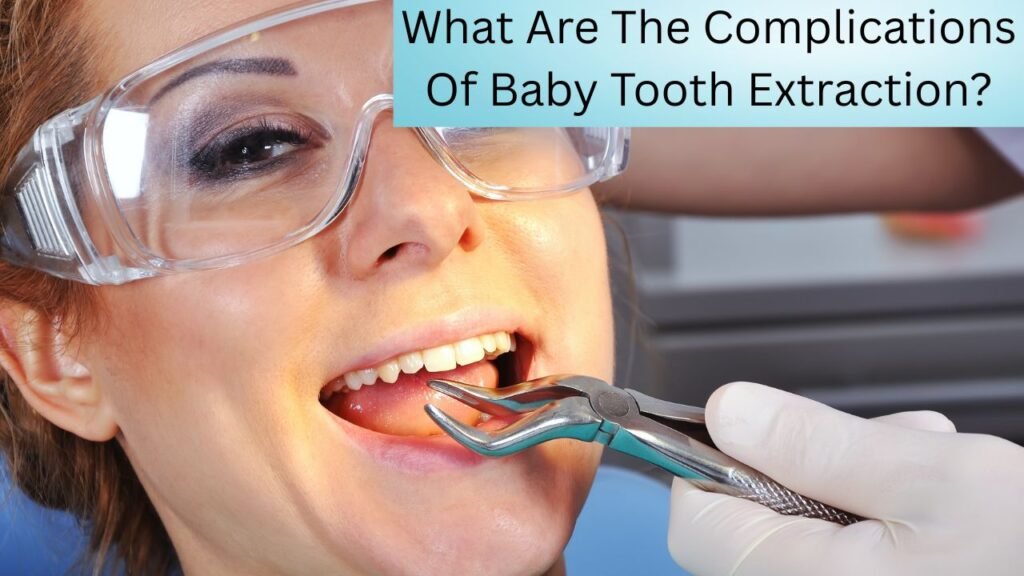If you’re here, chances are your child has a baby tooth that’s gotta go—and you’re a bit freaked out about it. Totally normal. Whether it’s a stubborn baby molar that refuses to budge or a decayed tooth causing pain, tooth extractions in kids are more common than you’d think.
But as a parent, you’re not just concerned about the procedure—you’re wondering:
👉 What happens after? What could go wrong? How will my kid feel?
Let’s walk through this together. This guide will break down real complications that can occur after a baby tooth extraction, how likely they are, what signs to watch for, and what to do about them.

🚩 Quick Overview: Common Complications & What They Mean
Here’s a glance at what could potentially happen after a baby tooth is pulled:
| Complication | Likelihood | What It Means |
|---|---|---|
| Pain & Swelling | Common | Body’s natural healing response. Usually mild. |
| Bleeding | Common | Light bleeding is normal for a few hours after. |
| Dry Socket (Alveolar Osteitis) | Rare in children | Blood clot dislodges, causing pain. Less likely in kids. |
| Infection | Relatively Common | Can develop if aftercare isn’t followed. Watch for fever or pus. |
| Delayed Healing | Rare | Often due to health or nutritional issues. |
| Nerve Injury | Extremely Rare | Only if nearby nerve tissues are disturbed. |
| Emotional Distress | Common | Kids might feel scared or avoid brushing near the site. |
🤕 1. Pain and Swelling – What’s Normal, and What’s Not
Let’s start with the most obvious one: pain.
Your child will likely feel a little sore where the tooth came out. Some swelling might show up on the cheek too. This is all part of the healing process.
✅ What’s normal:
- Mild throbbing or aching for 1–2 days
- Slight facial puffiness
- Needing Tylenol or ibuprofen occasionally
⚠️ What’s not normal:
- Sharp, shooting pain that gets worse after 48 hours
- Pain that doesn’t go away with regular kids’ meds
- Crying that seems unusual or persistent
If pain worsens instead of improving, or if your child starts avoiding eating, it’s time to call the dentist.
🩸 2. Bleeding – When Should You Worry?
Right after the extraction, it’s expected to see some blood. That’s the body doing its job—forming a clot to start healing.
✅ What’s normal:
- Oozing or light bleeding for a few hours
- A bit of blood in saliva
- Stopping after biting down on gauze for 30–60 minutes
⚠️ What’s not normal:
- Soaking a gauze pad every 15–20 minutes for more than 2 hours
- Blood suddenly restarting after stopping
- Bleeding that continues into the next day
Use clean gauze or a damp tea bag (the tannins help clotting). If bleeding doesn’t slow down, seek dental or urgent care.
🦠 3. Infection – Signs You Shouldn’t Ignore
Post-extraction infections in children aren’t super common, but they can happen—especially if your kiddo touches the area with dirty hands or doesn’t rinse properly.
Infections are usually caused by bacteria like Streptococcus mutans, Lactobacillus, or Actinomyces.
🚨 Symptoms to watch for:
- Bad breath (even after brushing)
- Yellow or white pus at the site
- Swelling that worsens
- Fever or chills
- Swollen lymph nodes (especially near the jaw)
If you see any of these, contact your pediatric dentist right away. Early treatment usually involves antibiotics and mouth rinses.
🏴☠️ 4. Dry Socket – Rare But Painful
Dry socket is one of those complications that sounds scarier than it usually is—but it can be very painful.
In adults, it’s more common. But in kids? Very rare.
Why?
Children’s baby teeth have shallower roots, and their jawbone density is different. This makes dry socket less likely.
What it feels like:
- Pain that gets worse 2–4 days after the extraction
- Empty-looking socket (no blood clot visible)
- Bad taste or smell in the mouth
Your dentist can place a medicated dressing to ease the pain and help heal the area.
🕒 5. Delayed Healing – When It’s Not Going as Planned
If healing takes longer than expected, it might not be anything major. But in some cases, underlying health issues could be playing a role.
Contributing factors:
- Diabetes (even in young children)
- Iron-deficiency anemia
- Vitamin C or D deficiencies
- Autoimmune conditions
If your child isn’t healing well, it’s worth discussing their medical history and diet with your dentist or pediatrician.
⚡ 6. Nerve Injury – Almost Never, But Still Possible
This one’s extremely rare in kids. Most baby teeth are far from major nerve pathways. But if the tooth was near the inferior alveolar nerve, there’s a tiny chance of numbness or tingling.
This usually resolves on its own, but any persistent numbness in the chin, tongue, or lower lip should be checked out.
🧠 7. Emotional Reactions – The Mental Side of It
Let’s not forget—the mouth is a sensitive place. For some kids, getting a tooth pulled is a big deal.
They might be:
- Afraid of brushing near the site
- Anxious about going to the dentist again
- Crying during meals or skipping food altogether
Patience is key. Soft foods, lots of reassurance, and maybe even a post-visit treat can go a long way in helping your child bounce back emotionally.
conclusion:
Most of the time, baby tooth extractions heal smoothly. But when things feel off, trust your gut and don’t hesitate to call your dentist.
Post-care tips to prevent complications:
- Keep your child from rinsing too hard or sucking on straws
- Help them gently brush around the area
- Stick to soft, cool foods for a day or two
- Monitor for signs of infection or excessive bleeding
Find Your Perfect Dentist
Book appointments with top-rated dentists in your area